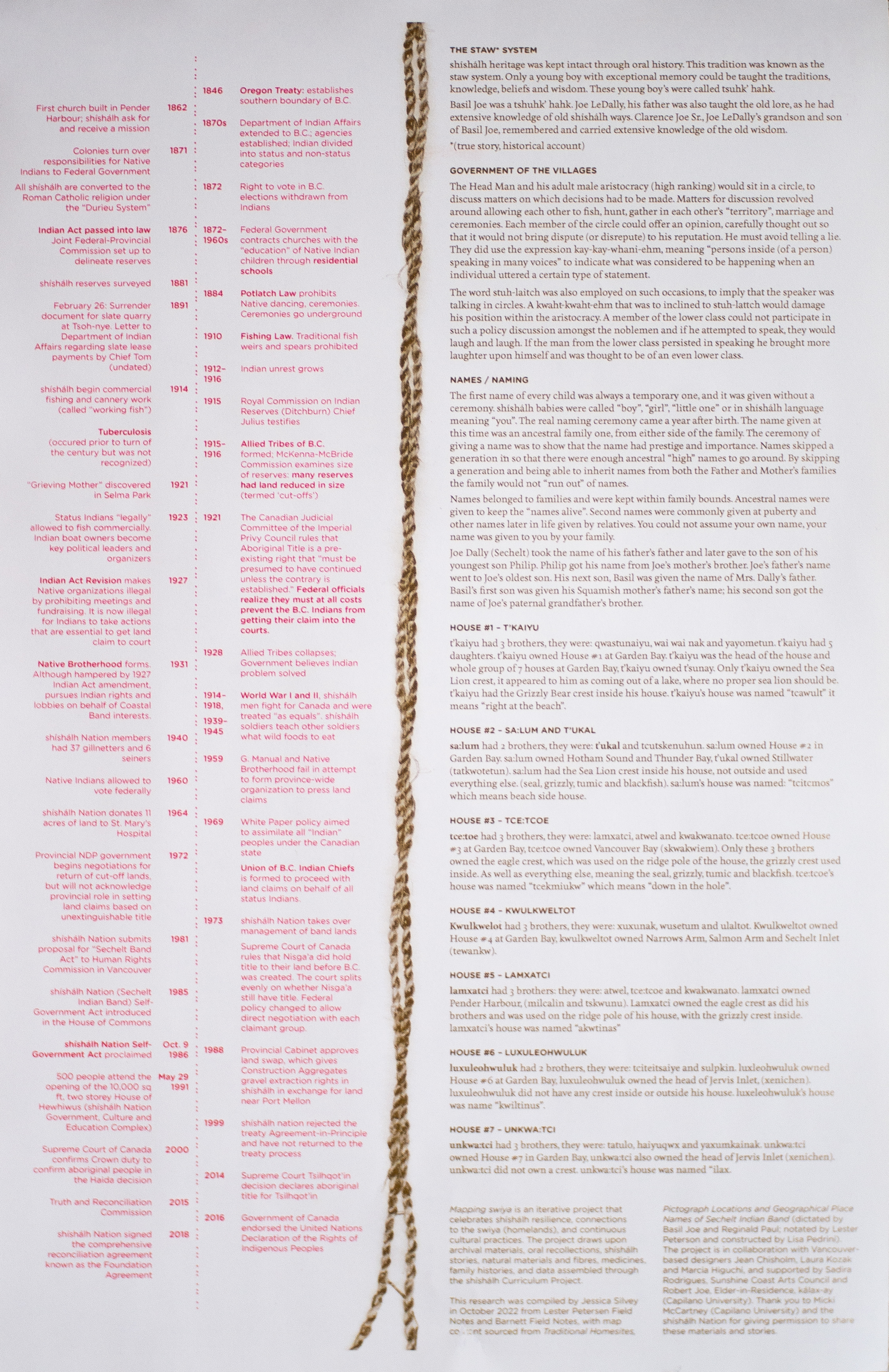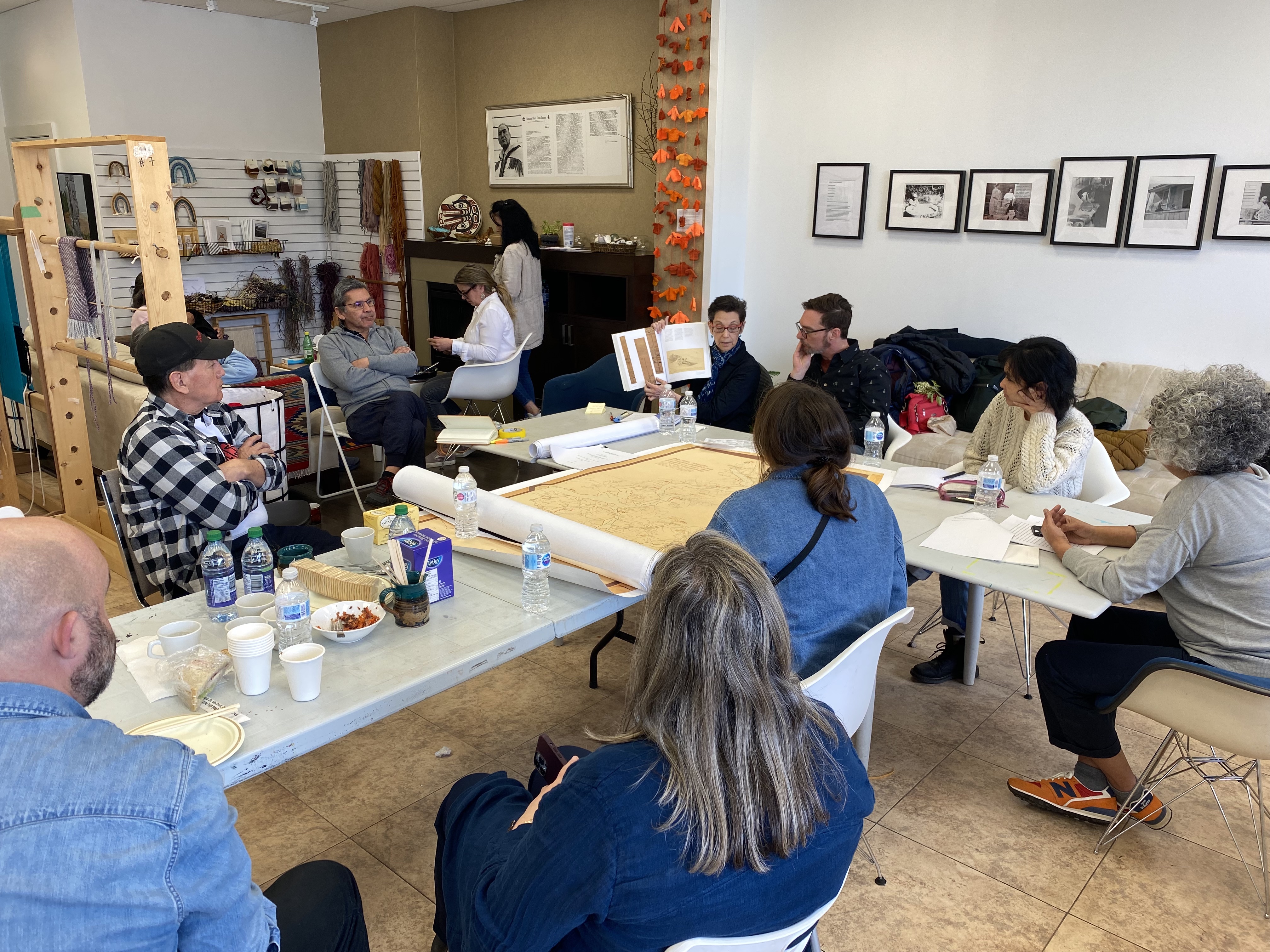Mapping swiya
2022-2024
2022-2024
Mapping swiya: A case study in place-based research ethics, researched and designed with Laura Kozak
and Marcia Higuchi, in partnership with Sunshine Coast Arts
Council.
In 2022, Robert Joe, shíshálh Elder-in-Residence at Capilano University and Coast Salish master weaver Jessica Silvey began assembling a variety of sources to map their Nation’s history and territory in partnership with Sadira Rodrigues, Director/ Curator, Sunshine Coast Arts Council (SCAC). This group engaged a design team from Emily Carr (Jean Chisholm, Marcia Higuchi and Laura Kozak) to prototype a translation of this material to large-scale form for the CapU campus, where many of the Nation’s youth begin post-secondary studies.
Phase One (completed November 2022) includes a wall-sized map of the shíshálh swiya (homelands) and traditional place names alongside a 24’ timeline detailing specifics of epidemics, changes to land title, residential school, cultural events and images held within the Nation’s archives. Simple prints and images were wheat-pasted to the hallway of CapU, creating an accessible model for students and teachers to add to.
Phase Two (Spring 2024) designed this map into riso-printed poster to be shared at community events, layering in additional histories and stories from local knowledge-keepers, gathered in response to the wall mural. Understanding the factual truths and specific details of the impacts of colonialism is fundamental for healing and resurgence of story and pride in culture.
In 2022, Robert Joe, shíshálh Elder-in-Residence at Capilano University and Coast Salish master weaver Jessica Silvey began assembling a variety of sources to map their Nation’s history and territory in partnership with Sadira Rodrigues, Director/ Curator, Sunshine Coast Arts Council (SCAC). This group engaged a design team from Emily Carr (Jean Chisholm, Marcia Higuchi and Laura Kozak) to prototype a translation of this material to large-scale form for the CapU campus, where many of the Nation’s youth begin post-secondary studies.
Phase One (completed November 2022) includes a wall-sized map of the shíshálh swiya (homelands) and traditional place names alongside a 24’ timeline detailing specifics of epidemics, changes to land title, residential school, cultural events and images held within the Nation’s archives. Simple prints and images were wheat-pasted to the hallway of CapU, creating an accessible model for students and teachers to add to.
Phase Two (Spring 2024) designed this map into riso-printed poster to be shared at community events, layering in additional histories and stories from local knowledge-keepers, gathered in response to the wall mural. Understanding the factual truths and specific details of the impacts of colonialism is fundamental for healing and resurgence of story and pride in culture.




Place-Based Responsibility Context Paper
2021
2021
Written with Laura Kozak, this paper provides a brief context and framing for a series of roundtables, guided walks, class activities, research projects and resource sharing under the broad umbrella of Place-Based Responsibility. This practice invites and explores a variety of forms of gathering, collaboration, and learning as we collectively take up this question.
Read contextual paper
Read contextual paper

Propositions for a Place-Based Practice: Implicating the Designer in Care and Relationality
2020
2020
This thesis reflects on the role of the designer within a place-based practice, exploring the implications of being knowingly and intentionally embedded within community and building a design practice rooted in relationality and reciprocity. Propositions for a place-based practice emerged from a methodology of material and collaborative making, as examined through three case studies (two completed, one proposed) within Prince George and Vancouver, Canada.
Read thesis document
Read thesis document



